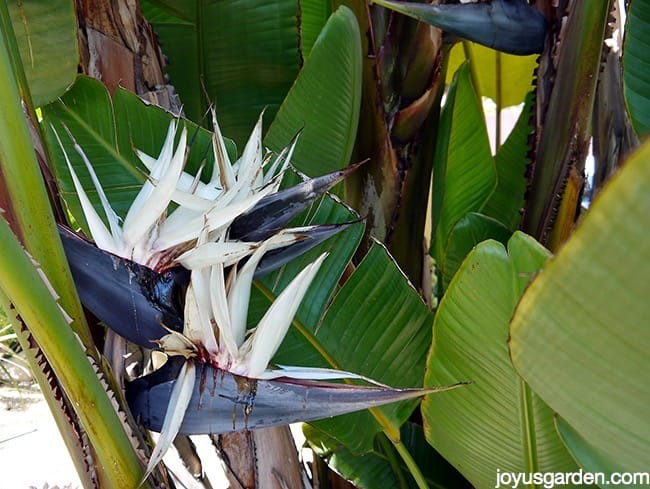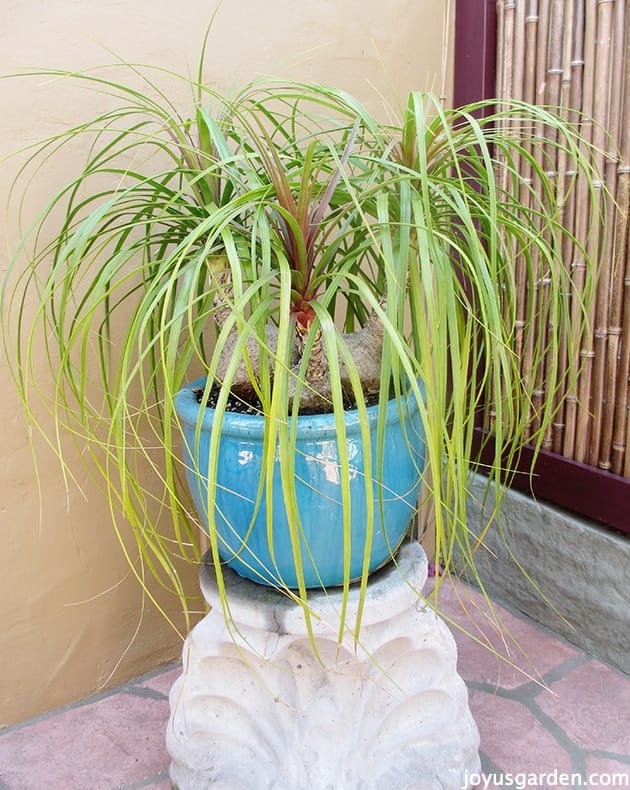Why Are My Giant Bird Of Paradise Leaf Edges Turning Brown?
The question is regarding brown leaf edges on a Giant Bird of Paradise. A few reasons cause this along with splitting leaves.
I receive so many questions here, on my videos and via email. I decided to start a segment called “Ask Nell” because you all might have the same questions and/or be interested in the answers. The first one comes from Patti regarding her Giant Bird Of Paradise, or Strelitzia nicolai.

The photo you see above was sent to me by Patti. These plants are native to subtropical coastal forests of South Africa where the humidity is higher and there’s more rainfall.
This is especially true in California these days as we’re in the midst of a megadrought; yes, it’s extreme. It’s common for the edges of these plants brown but nowadays they’re downright crispy because even the maritime layer, aka fog, has been almost nonexistent.
You can see my Giant Bird of Paradise in this video as well as the Bird of Paradise you are probably more familiar with:
Also, you see a lot of split Giant Bird Of Paradise leaves and that is because of the wind. As with most plants, the older leaves will brown, yellow and split more than the younger ones.
The leaves get browner and more raggedy as they get older. They don’t need much water at all once they get established but we haven’t been receiving enough winter rain to hold them through our dry months. After all, they do need some water … not no water.
So Patti, water yours deeply every 2-3 months (until we get some substantial winter rains) and give it a 2-3″ layer of some rich, organic compost to help hold that moisture in. The compost will also enrich the soil naturally making the roots and the plant grow stronger.
The bottom line:
You can reduce the brown edging to an extent but if your Giant Bird Of Paradise is in a windy area, the leaves will split. Nothing you can do about that!

I’m including a bit about the Bird Of Paradise, Strelizia reginae, in here because the same applies to them. It’s not as noticeable on them because their leaves are smaller and seem to be a bit tougher. I’ve been noticing quite a bit of leaf curling on these plants around town because we’re so darned dry.
If you happen to have 1 as a houseplant and the edges are brown, it’s because the air in our homes is much drier than they’d like it to be. The average home is not the subtropics after all!
Thanks for the question Patti. If any of you have a question for me regarding plants, flowers and/or gardening, simply leave it below this post, in the video comment section or send it to info@joyusgarden.com (if you do this, please put “ask nell” in the subject line). Now let’s get gardening and make the world a more beautiful place!

This post may contain affiliate links, you can read our policies here.
- About the Author
- Latest Posts
Nell, the founder of Joy Us garden, was born into a gardening family and grew up in Connecticut’s countryside. After living in Boston, New York, San Francisco, & Santa Barbara, she now calls the Arizona desert home. She studied horticulture & garden design, working in the field all her life. Nell is a gardener, designer, blogger, Youtube creator, & author. She’s been gardening for a very long time & wants to share what she’s learned with you.






My plant had, finally, after five years first two flowers. But before it would bloom, it started to turn brown and was dying. Does anyone know why? I had to cut both off and when looked inside, the flower was soggy and dark brown.Thank you
Hi Anita – I believe that is a fungal disease. This is common in periods when it’s wet & cool. Nell
Hi there
I have 8-10 yr old large bird of paradise, white. The leaves are all split. looks like a banana plant. They come out nice but quickly split. Any way to stop this. Some food? More water??
Hi Chris – There’s nothing that I know of that you can do, it’s just the nature of the plant. In windy conditions, the mature leaves will split even more. Nell
Hi, my giant bird of paradise is turning yellow all over and the leaves are drooping. We have others either side that are flourishing so not sure why this one isn’t?
Thanks heaps
Allyson
Hi Allyson – It’s hard to say why 1 plant flourishes & the 1 next to it doesn’t. I can tell you that yellow leaves on a GBOP are due to too much water or too little water. They don’t like to be too wet or too dry. Perhaps the drainage in that 1 spot isn’t as good as where the others are growing. Nell
I live in North Dallas. I bought a bird of paradise while out in San Diego about 17 yrs ago. It has grown, made a change of location with us 11 yrs ago in the same pot, but I replanted it in the ground near a water spout. It grow, died back in winter, came back in summer until I put it in a new pot, about 3 yrs ago, that could be protected over winter. It has never bloomed. I know, it’s been through a lot and hung in there. Should I just give up or do you think it will ever bloom?
Hi Joan – It takes them a while to flower after being transplanted because they actually bloom better when slightly pot bound. It’s gone through a few experiences which would deter blooming. I’d give it more time. They bloom best in full sun by the way. Nell
Hi,
I have 2 of the plants inside my house. none of them have bloomed so far. One of them has sticky, substance dripping from the leaves onto my wooden floor all the time. Is this normal?
Hi Raj – The flowers of a Giant Bird of Paradise secrete sap but it sounds like that’s not causing it. Your plants most likely have some kind of insect infestation. The insects suck the sap (which is sticky) from the plant & then secrete what they can’t consume. Nell